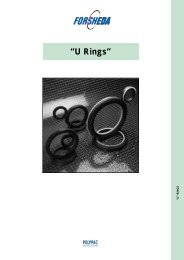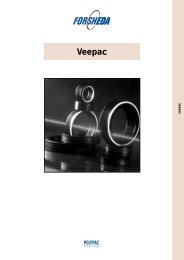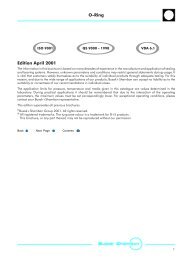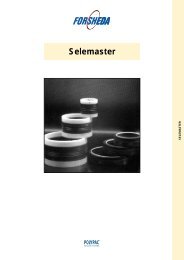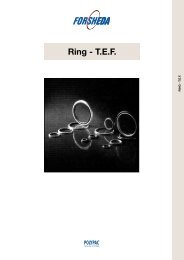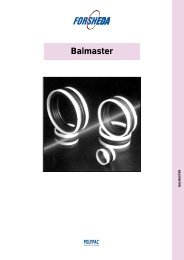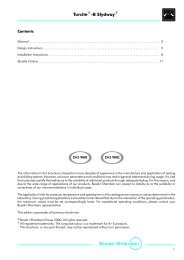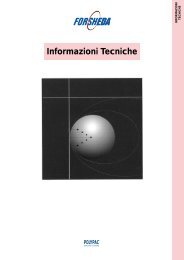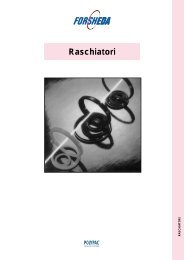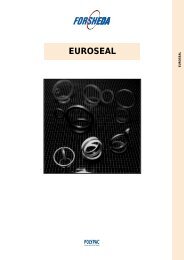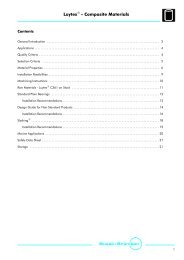Rotary Seals - Dilanda.it
Rotary Seals - Dilanda.it
Rotary Seals - Dilanda.it
Create successful ePaper yourself
Turn your PDF publications into a flip-book with our unique Google optimized e-Paper software.
<strong>Rotary</strong> Seal<br />
n Qual<strong>it</strong>y cr<strong>it</strong>eria<br />
The cost-effective use of seals and bearings is highly<br />
influenced by the qual<strong>it</strong>y cr<strong>it</strong>eria applied in production.<br />
<strong>Seals</strong> and bearings from Busak+Shamban are continuously<br />
mon<strong>it</strong>ored according to strict qual<strong>it</strong>y standards from<br />
material acquis<strong>it</strong>ion through to delivery.<br />
Certification of our production plants in accordance w<strong>it</strong>h<br />
international standards QS 9000 / ISO 9000 meets the<br />
specific requirements for design, qual<strong>it</strong>y control and<br />
management of purchasing, production and marketing<br />
functions.<br />
Our qual<strong>it</strong>y policy is consistently controlled by strict<br />
procedures and guidelines which are implemented w<strong>it</strong>hin<br />
all strategic areas of the company.<br />
All testing of materials and products is performed in<br />
accordance w<strong>it</strong>h accepted test standards and specifications,<br />
e.g. random sample testing in accordance w<strong>it</strong>h DIN<br />
ISO 2859, part 1. Inspection specifications correspond to<br />
standards applicable to individual product groups (e.g. for<br />
O—Rings: ISO 3601).<br />
Our sealing materials are produced free of<br />
chlorofluorinated hydrocarbons and carcinogenic<br />
elements.<br />
The tenth dig<strong>it</strong> of our part number defines the qual<strong>it</strong>y<br />
characteristics of the part. A hyphen indicates compliance<br />
w<strong>it</strong>h standard qual<strong>it</strong>y cr<strong>it</strong>eria outlined in this catalogue.<br />
Customer-specific requirements are indicated by a different<br />
symbol in this pos<strong>it</strong>ion. Customers who require special<br />
qual<strong>it</strong>y cr<strong>it</strong>eria should contact their local Busak+Shamban<br />
sales office for assistance. We have experience in meeting<br />
all Customer qual<strong>it</strong>y requirements.<br />
n Storage and shelf life<br />
<strong>Seals</strong> and bearings are often stored as spare parts for<br />
prolonged periods. Most rubbers change in physical<br />
properties during storage and ultimately become<br />
unserviceable due to e.g. excessive hardening, softening,<br />
cracking, crazing or other surface degradation. These<br />
changes may be the result of particular factors or<br />
combination of factors, such as the action of<br />
deformation, oxygen, ozone, light, heat, humid<strong>it</strong>y or oils<br />
and solvents.<br />
W<strong>it</strong>h a few simple precautions, the shelf life of these<br />
products can be considerably lengthened.<br />
Fundamental instructions on storage, cleaning and<br />
maintenance of elastomeric seal elements are described<br />
in international standards, such as:<br />
DIN 7716 / BS 3F68:1977,<br />
ISO 2230, or<br />
DIN 9088<br />
The standards give several recommendations for the<br />
storage and the shelf life of elastomers, depending on<br />
the material classes.<br />
The following recommendations are based on the several<br />
standards and are intended to provide the most su<strong>it</strong>able<br />
cond<strong>it</strong>ions for storage of rubbers. They should be observed<br />
to maintain the optimum physical and chemical values of<br />
the parts:<br />
Heat<br />
The storage temperature should preferably be between<br />
+5 °C and +25 °C. Direct contact w<strong>it</strong>h sources of heat such<br />
as boilers, radiators and direct sunlight should be avoided.<br />
If the storage temperature is below +5 °C, care should be<br />
taken to avoid distorting them during handling at that<br />
temperature as they may have stiffened. In this case the<br />
temperature of the articles should be raised to<br />
approximately +20 °C before they are put into service.<br />
Humid<strong>it</strong>y<br />
The relative humid<strong>it</strong>y in the store room should be below<br />
70 %. Very moist or very dry cond<strong>it</strong>ions should be avoided.<br />
Condensation should not occur.<br />
Light<br />
Elastomeric seals should be protected from light sources, in<br />
particular direct sunlight or strong artificial light w<strong>it</strong>h an<br />
ultraviolet content. The individual storage bags offer the<br />
best protection as long as they are UV resistant.<br />
It is advisable to cover any windows of storage rooms w<strong>it</strong>h<br />
a red or orange coating or screen.<br />
Latest information available at www.busakshamban.com<br />
Ed<strong>it</strong>ion April 2006<br />
13



